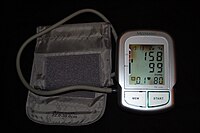
Photo from wikipedia
Backgrounds We aimed to investigate the demographic characteristics, vascular involvement, angiographic patterns, complications, and associations of these variables in a large sample of TAK patients at a national referral center… Click to show full abstract
Backgrounds We aimed to investigate the demographic characteristics, vascular involvement, angiographic patterns, complications, and associations of these variables in a large sample of TAK patients at a national referral center in China. Methods The medical records of TAK patients discharged from 2008 to 2020 were retrieved from the hospital discharge database using ICD-10 codes. Demographic data, vascular lesions, Numano classifications and complications were collected and analyzed. Results The median age at onset was 25 years in 852 TAK patients (670 female, 182 male). Compared with the females, the male patients were more likely to have type IV and were more likely to have iliac (24.7% vs. 10.0%) and renal artery (62.7% vs. 53.9%) involvement. They also had a higher prevalence of systemic hypertension (62.1% vs. 42.4%), renal dysfunction (12.6% vs. 7.8%) and aortic aneurysm (AA) (8.2% vs. 3.6%). The childhood-onset group was more likely to have involvement of the abdominal aorta (68.4% vs. 52.1%), renal artery (69.0% vs. 51.8%) and superior mesenteric artery (41.5% vs. 28.5%), and they were more likely to have type IV, V and hypertension than the adult-onset group. After adjusting for sex and age at onset, the patients with type II were associated with an increased risk of cardiac dysfunction (II vs. I: OR = 5.42; II vs. IV: OR = 2.63) and pulmonary hypertension (II vs. I: OR = 4.78; II vs. IV: OR = 3.95) compared with those with types I and IV. Valvular abnormalities (61.0%) were observed to be most prevalent in patients with type IIa. The patients with Type III were associated with a higher risk of aortic aneurysm (23.3%) than the patients with types IV (OR = 11.00) and V (OR = 5.98). The patients with types III and IV were more commonly complicated with systemic hypertension than the patients with types I, II and V. P < 0.05 in all of the above comparisons. Conclusion Sex, adult/childhood presentation and Numano angiographic type were significantly associated with differences in phenotypic manifestations, especially cardiopulmonary abnormalities, systemic hypertension, renal dysfunction and aortic aneurysm.
Journal Title: Frontiers in Cardiovascular Medicine
Year Published: 2023
Link to full text (if available)
Share on Social Media: Sign Up to like & get
recommendations!